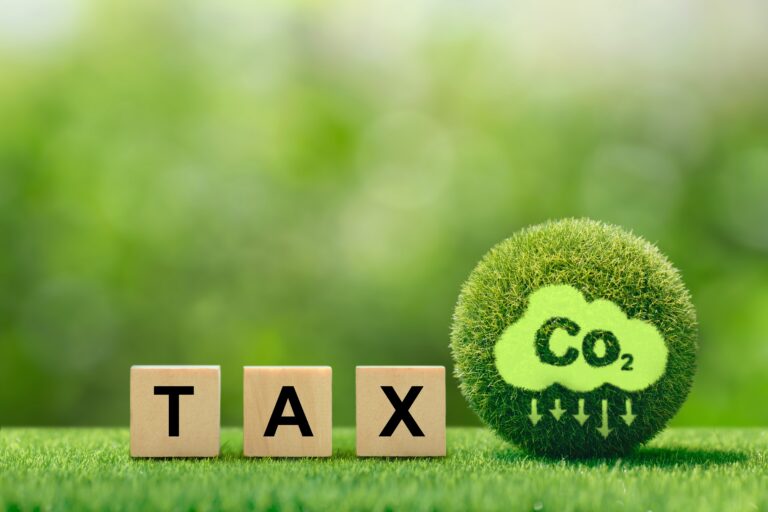
Putting a price on greenhouse gas (GHG) emissions is seen by many as the most efficient way to deal with the effects of climate change.
Carbon-pricing schemes are proliferating in the form of carbon taxes and market-based emissions trading.
The World Bank has counted 73 carbon-pricing mechanisms around the world. They now cover 23% of global emissions compared to just 5% in 2010.
Carbon prices aim to put a value on the pollution that is behind global warming and to limit carbon emissions that continue to rise.
The idea is simple and generally supported by many mainstream economists.
Putting a price on carbon, in principle, identifies the cheapest greenhouse gas emissions to cut first and thereby supports measures that tackle climate change at the lowest cost.
It charges the polluters and allows for the proceeds to be redistributed to those impacted most by the pollution or its associated costs.
Having to consider carbon prices also forces companies to track their emissions and helps investors identify the dirtiest assets.
In practice, direct carbon-pricing schemes are often gradually implemented in stages.
First, governments create a market for emissions combined with carbon taxes, credits, or allowances. That markets requires participants to disclose their emissions, set emissions targets and either pay emissions levies or purchase emissions rights.
Then initially voluntary schemes are made mandatory; thresholds for mandatory participation are gradually lowered; the range of covered industries or goods is widened, or free allowances are phased out.
Ultimately, the mechanism is extended extraterritorially, for example, in the absence of multilateral schemes, by covering imports.
This planned gradual tightening of direct pricing mechanisms has become an almost universal feature from China, Indonesia, Japan and Vietnam to Australia.
The EU’s carbon border adjustment mechanism
On Oct 1, the European Union launched the most ambitious scheme so far: the carbon border adjustment mechanism (CBAM).
From 2026, the programme will begin to charge a price on the carbon emitted during the production of carbon-intensive goods imported into the EU. The CBAM will cover iron, steel, cement, aluminium, fertiliser, hydrogen and electricity generation.
By increasing the cost of imports, the mechanism puts pressure on European companies and their global suppliers to go green, and on governments outside the EU to create similar carbon price setting schemes.
This is done by forcing importers to pay the difference between the carbon emission cost of the imported goods under the EU scheme and any carbon price paid in the exporter’s home market.
Exporter countries therefore have an incentive of taxing carbon emissions themselves as taxes would otherwise be collected by the EU. Producer companies have the additional incentive of reducing costs by lowering emissions.
During the pilot phase of the CBAM, suppliers from non-EU countries must, by January 31, 2024, for the first time, report emissions resulting from their production processes, starting with the fourth quarter 2023.
If they do not have such data, importers must use values that will be provided by the EU before the end of this year, based on the highest polluting reference companies in the bloc.
Once the permanent system enters into force in 2026, importers will need to declare each year the quantity of goods imported into the EU in the preceding year and their embedded GHG.
They will then buy the corresponding number of CBAM certificates. The price of the pollution certificates will be calculated depending on the weekly average auction price of EU Emissions Trading Scheme (ETS) allowances expressed in €/tonne of CO2 emitted. This price is currently about €85.
As the CBAM is rolled out, the EU will phase out free allowances under the EU ETS.
Several exporter countries to the EU, including China and India, have already registered their complaints to be discussed at the World Trade Organization. However, the objections are unlikely to be successful.
European companies currently face higher carbon costs than importers and the CBAM was designed to eliminate so-called ‘carbon leakage’. This is the risk that EU companies would move production to countries with less stringent climate policies or replace EU-sourced goods with goods from countries, where carbon prices are lower or non-existent.
The Economist argued in October that the CBAM could start a domino effect of other countries following suit. In fact, the Biden Administration in the United States at some point mulled its own border adjustment tariff for carbon, but domestic carbon pricing appears to be politically unviable at this stage. Although US companies prefer carbon taxes over emissions caps and limits, the Biden Administration has chosen subsidies as the main de-carbonisation tool at the federal level.
At the US state level, California has a cap-and-trade system, while the Regional Greenhouse Gas Initiative (RGGI) is covering 11 north-eastern states. But their carbon prices are much lower than in Europe.
Criticism
Many of the carbon pricing schemes around the world will take time to have an impact. Others are just too weak and will have to be reformed to have any effect.
All of the schemes price carbon well below the EU’s current price of €85 per tonne of CO2, which itself is considered still shy of the total social cost.
Even in the UK, which since Brexit has its own emissions trading scheme, prices have fallen and started to diverge from EU prices. This was largely because the UK government watered down its national climate policies, and its reform of the ETS, including a reduction of tradable allowances, fell short of what the market expected. As a result, UK exporters to the EU are expecting to pay higher carbon levies in Europe.
In many cases worldwide, key industries, such as transport or construction, are exempt or subject to weaker rules, and carbon prices often apply only indirectly to consumers. Even when they do, they are seen as inequitable.
One criticism of carbon taxes and other carbon price mechanisms is that because they tend to raise energy prices, they are hitting the poorest in society more heavily.
The Platform for Collaboration on Tax (PCT), a joint initiative of the International Monetary Fund (IMF), the Organisation for Economic Co-operation and Development (OECD), the United Nations (UN), and the World Bank Group (WBG) reported in September that as the number of carbon pricing instruments has increased steadily over the last three decades, a wide range of carbon pricing metrics has been developed.
The different forms of carbon pricing are either explicit (carbon taxes), implicit (fuel taxes), positive (emissions trading systems), or negative (subsidies) but mostly complement each other, a PCT report found.
However, the PCT partners agreed that to date carbon pricing signals are still insufficient, and energy prices remain poorly aligned with climate, environmental and health costs.
Current price signals are also inconsistent with carbon content, as the most polluting fuels face the lowest carbon price rates.
According to the OECD, in 2018-2021, 59.3% of greenhouse gases were not subject to a positive carbon price, implying considerable opportunities to advance CO2 pricing.
The World Bank highlighted that while direct carbon prices recently hit record highs in many countries, less than 5% of global emissions are currently covered by a direct carbon price within the range needed to achieve climate goals by 2030.
Yet even limited carbon-pricing programmes can still alter behaviour and have some impact, simply by encouraging the monitoring of emissions.
At the same time, academic studies have shown that when applied more firmly, carbon-pricing schemes have effectively lowered emissions.
In September, European Commission President Ursula von der Leyen called on international leaders to develop a plan for a global carbon price and effective carbon credits at this year’s UN Climate Change Conference, taking place in Dubai, UAE, from Nov. 30 to Dec. 12.
“I believe… that setting a price on carbon emissions is one of the most efficient and one of the most effective tools in our hands. Because it fosters innovation by the private sector – that is crucial,” she said.
“Because it makes heavy polluters pay a fair price – that is necessary. And because it creates revenues that can support the clean transition in developing countries – that is what we need.”
Even short of such a global solution, cross-border schemes like the EU’s CBAM show how more consistent carbon prices could spread further around the world.


